Though the charge from Missouri Gov. Jay Nixon to the Ferguson Commission was to conduct a “thorough, wide-ranging and unflinching study of the social and economic conditions that impede progress, equality, and safety in the St. Louis region,” and “to examine the underlying causes of these conditions, including poverty, education, governance, and law enforcement,” it was not a foregone conclusion that the commission would call out race as an underlying cause.
Had the Ferguson Commission followed the lead of its predecessors, it would not have.
Political scientist Lindsey Lupo examined five so-called “riot commissions” that had been appointed in response to uprisings between 1919 and 1992. In her book Flak-Catchers: One Hundred Years of Riot Commission Politics in America, she writes that these commissions “give the appearance of action but are little more than a tool to maintain the status quo,” and that, “social and racial issues in the cities are not actually addressed by the commission.”
They focus on economic revitalization “to the exclusion of social issues, such as racial tension, segregation and discrimination. It is as though the commissions are arguing that our society has moved beyond race, thus the problems must be purely economic. But race remains at the root of the violence, as evidenced by its very inception with every riot studied here being the result of White law enforcement harming a Black civilian.”
In its report, released in Sept. 2015, the commission cited Lupo’s work, and declared: “We have not moved beyond race.”
That the commission delivered a report at all was a victory.
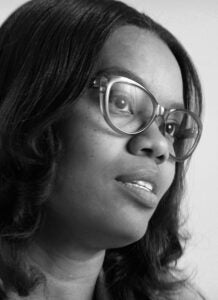
“Commissions were known in the past to not be successful,” says Brown School alum Bethany Johnson-Javois. Johnson-Javois was named one of 16 commissioners in Nov. 2014, and then in Jan. 2015 was appointed managing director of the commission. “They were known to be token efforts by leaders to say that they did something and checked the box,” she says. “Reports were known to go on shelves. The challenge was to undo the history of all that had come before us.”
The creation of the commission drew skepticism, even from then-Lt. Gov. Peter Kinder. At an event announcing the commission members, Kinder declared,” Since I heard about the idea of this commission, I have conducted my own survey of Missourians wherever I went in the state for the last two months, and I have not found one person – Democrat, Republican or Independent – who believes that a commission sitting and taking testimony and producing a report that is going to gather dust on shelves is going to be a big part of the solution to Ferguson.” Kinder had earlier voted against a $100,000 grant to help fund the Commission.
But despite the doubts and opposition, in the 10 months between its appointment in Nov. 2014 and the release of its report in Sept. 2015, the commission held 19 open community meetings throughout the St. Louis region, 38 working group meetings, and 12 small community discussion meetings. It heard from more than 80 subject matter experts, engaged in more than 100 conversations with regional leaders, and at its public meetings, met with more than 3,000 community members from across the region who shared stories, personal experiences, and recommendations. Between commissioners, working group members, and other citizens who engaged in the process, the commission estimated that more than 30,000 volunteer hours were contributed to its work.
In its final 198-page report and companion website, the commission identified 189 calls to action, naming accountable bodies for each.
“In some ways, frankly, we did the impossible because the truth is I really don’t believe that there was a true desire that there would be success of the commission or that a report of any kind would actually be released,” Johnson-Javois says. “The time frame [we were given], the way that the resources did and didn’t play out … to be able to produce the charge that the governor gave us was actually miraculous.”
The compressed timeline wasn’t the only challenge. Because the commission was a state entity, it was subject to Sunshine Laws, meaning whenever more than half of the commissioners were in the same room, the meeting had to be open to the public, with notes, resources, transcripts, and video from the meeting openly shared online. While the commission prioritized openness and transparency, this constraint made it difficult for the commissioners, all in high-visibility, high-stakes roles, to speak as often or as candidly as they might like. And because the commission was a state entity, it was subject to state procurement rules, so simply getting and spending the funds that it had been granted by the state and given by donors meant navigating layers of paperwork and state bureaucracy.
For all the structural and logistical challenges, “What was never a challenge was the clear articulation of the people from day one on the expectations they had, and the vision that they set,” she says. “The challenge … was trying to get it all condensed into paper.”
Several moments stand out from the early meetings of the commission that clarified the people’s expectations.
At a youth convening, Johnson-Javois remembers, “A young man approached the mic as we sat in front of him, and he gave us a photo of his son, who had to have been less than a year old. He said to us that he had an expectation of us and a desire for us to remember the face of his son as we thought about our work, and the urgency of what it meant for him to want to be around and protected and to be safe and to be alive [for his son], while also thinking about the longevity of his son in this region, and what that meant.”
At another meeting, “I remember several people saying, ‘No one in elected position has shown up for us. No one’s asked us if we’re OK. We don’t know you all, and frankly we don’t trust you, but you’re here. We expect you to be accountable — and you’re accountable.’ That statement, and the photo that the young man showed me of his family and himself has affected me to this day,” Johnson-Javois says.
Those community voices clarified for her who the commission was truly accountable to — and brought home “the weight of responsibility and accountability to make sure that the stories [we heard] weren’t just stories, and that we didn’t [offer] quick fixes, that we really did think about the generational pieces of how St. Louis needs to be different.”
Though citizen stories provided the heart and the guts for the report, the backbone of the report was data.
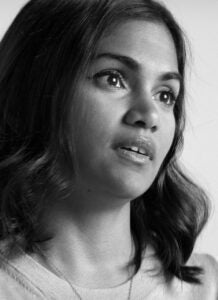
“It was a supplement to the lived experiences, the human testimony that was being brought to that commission day after day, meeting after meeting,” says Karishma Furtado, a candidate in the Brown School’s Public Health Sciences PhD Program. Furtado served the commission as its research and data consultant. “We recognized that there were those for whom the anecdotal story of individuals wasn’t going to be enough to change their mind or change their heart, and that we could make an even more compelling, from-all-angles case if we infused data that took the experience of that one person and showed how it was just one of many, and not a blip that could be ignored,” she says. Most of the data the commission included in its report had been published previously in individual studies, little noticed beyond academia and policy wonks. The commission leveraged the scrutiny it was under to draw attention to those data sets collectively, bringing them together to reveal the larger picture, and giving context to the personal experiences of people living in the St. Louis region.
“Fusing the data with the raw reality that people were bringing to the commission process was its true strength, and why it was so much more powerful than all these reports that existed before and that had … essentially lived in the papers that they were published in and in very few other places,” Furtado says.
Data has much more staying power when it’s tied to real humans, and human stories have much more staying power when tied to data.
Karishma Furtado
“Data has much more staying power when it’s tied to real humans, and human stories have much more staying power when tied to data. I think they make a very effective combination together. And I think the commission did a very good job of leveraging that.”
Another strength of the commission was the way it approached its work. It established four “Principles of Partnership” to guide commissioners and staff in their engagement with the community.
“The principles started off with radical listening,” a commitment to “listen to people who most closely experience inequity and trusting them as the experts for solving our problems,” says David Dwight IV, a 2015 graduate of the McKelvey School of Engineering. Dwight originally served the commission as communications and media intern, and eventually was hired to the commission staff to work with the Civilian-Law Enforcement Relations Working Group.
Jason Purnell, associate professor at the Brown School, attended some of the commission’s early meetings, where he saw the notion of radical listening put into practice. “People were angry, [those meetings] were heated, and the Ferguson Commission could’ve said, ‘This is too much. We can’t take this. We’re going to do this in a slightly more controlled, staid manner.’ But rather than doing that, they had the wisdom to sit and listen, and I think that made all the difference in the world,” he says. “It was true engagement.”
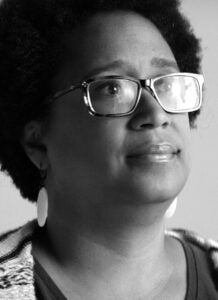
“Every time we had an open session, people would show up and say the same things, but they needed to say it, and they maybe needed to say it again. They had to get it out,” says Nicole Hudson, who served as communications director for the Ferguson Commission, and now serves as assistant vice chancellor for the Academy for Diversity, Equity, and Inclusion at Washington University. Though it could be hard to hear so many similar stories of trauma, Hudson saw something powerful in this approach to listening. “This ritual, this thing that seems like extra, that seems like we don’t have time for it, is actually fuel for the possible,” she says.
Purnell agrees. “The only way that we make effective change is with the people who are affected,” he says. “That’s the only way we get anything meaningful done.”
The second principle was applying a policy and systems focus, and “moving out of a programmatic approach to solving problems,” Dwight says. “St. Louis is regularly rated one of the most philanthropic cities in the country,” he says, and much of that philanthropy supports programs that help people and communities in need. Yet despite that generosity, St. Louis still has “some of the largest disparities, much larger than a lot of other urban areas,” Dwight says.
Investment in programs may be able to address the symptoms of inequity, but they don’t get at the causes. “How do we start to shift to transforming policies and systems, which are what created the St. Louis that we have now?” Dwight asks.
Applying a racial equity lens is the third principle. This meant considering race in the examination of every issue the commission explored. As every dive into the data revealed disparities along racial lines, “whether that’s actual life expectancy, health outcomes, graduation rates, infant mortality, who gets what jobs, what your wages are,” Dwight says, the commission committed to understanding how policy choices contributed to creating or exacerbating those disparities, and how policy changes could contribute to eliminating them.
The final principle was radical collaboration, “the idea that we have to put our egos aside and put the scarcity mentality aside and really center where we’re going,” Dwight says. “If we want to be a St. Louis where you can’t predict life outcomes by race, where our systems work well for all St. Louisans, that’s a very different sort of grounding than, ‘Will my nonprofit exist in two or three years? How does my business grow in the next two years?’ If [the question is] ‘How do we create a St. Louis region that’s thriving for all?’, that’s a different kind of outlook and causes us to work together differently.”
The commission’s commitment to those principles helped it earn trust among regional stakeholders, “so that when the report and the calls to action came forward, and when the context of people’s lived experience really was highlighted, that there was a receptivity [to them] and not a dismissal of the content nor the people nor the process,” Johnson-Javois says.
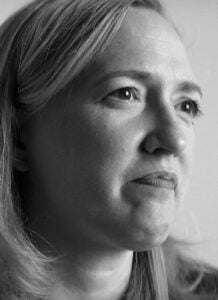
Lara Granich, who served on the commission’s Economic Mobility Working Group, appreciated the way the commission’s approach meant leaning in to difficult conversations. The working group “brought together people of very different perspectives on how our economy should work and what’s best for the economy in our community.” Though working group members often didn’t see eye-to-eye, “Something that was really powerful about what those working groups did was to contain that tension to actually bring people like that together to work with each other and work things out,” Granich says.
“The tension is important because it exists, and to pretend it doesn’t only leads to the kind of explosion we had in our community after Michael Brown was killed,” Granich says. “What we really need to do is design our processes, our institutions, our relationships and our community to harness tension in a way that moves us forward.”
The commission was also committed to ensuring that its report would be put to work, not gather dust on a shelf.
To avoid that fate, the commission never put it on a shelf in the first place — at least not officially. The report was released in digital format, as an interactive website and as a downloadable PDF. It still has not been released in any official printed format. But printed copies of that PDF abound.
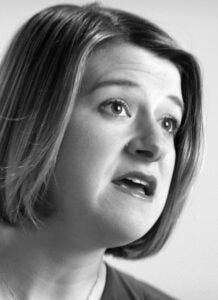
Lisa Clancy’s copy is “dog-eared, and I’ve got Post-it notes and highlights and notes all over it.” Clancy, a 2012 graduate of the Brown School, was elected to the St. Louis County Council in 2018. “It’s informed my work in really powerful ways,” Clancy says. “I return to it frequently. I recently sat down with the St. Louis County Chief of Police, and I prepared for that conversation by reviewing the Ferguson Commission report, specifically the piece of the report around police reform. “I think the Ferguson Commission report is something that policy makers and leaders in other capacities need to be referring to often. So much work went into it, there were so many voices that were heard. I think it’s one of the most powerful examples we have in our region of people coming together at various tables across lines of difference and coming to agreement on some changes that our region needs to make.” Of course, the commission’s goal was not simply to produce a report — it was to catalyze regional change. In the first months after the report was released, the commission took one final step that would support that objective. “The Ferguson Commission was originally only supposed to run until September of 2015,” Dwight says, “but the leaders of the commission and the leaders of the staff were really intentional about knowing that this could not just be a report that sat on the shelf. There had been too much insight from community members, too much generation and creation of new principles, of a new way of being in St. Louis, and a huge vision for how St. Louis could be different, what a new status quo could look like.” Not wanting all of that to evaporate upon the release of its report, commission leaders asked Gov. Nixon to extend the commission’s charge until Dec. 31, 2015, to give the commission and its staff time “to be intentional and to engage community members about what a continuing infrastructure looked like for equity work in the region,” Dwight explains.
“No commission before had centered race in the way the Ferguson Commission did, and no commission before had created an ongoing infrastructure,” Dwight says.
“The commissioners knew that there needed to be an organization or a network of organizations to continue the work and to be the holder of all that community knowledge that was created. Forward Through Ferguson was created at the beginning of 2016 to continue to hold space for these issues.”
Hudson became the organization’s first lead catalyst, and Dwight became the organization’s communications and strategy catalyst. (Dwight now serves as Forward Through Ferguson’s lead strategy catalyst.)
Dwight is quick to add that Forward Through Ferguson was not the only organization invested in continuing the work. “It was a lot of others as well — community organizers, people who were out on the street, others that had been doing this work that made sure [racial equity] stayed in our language across the region, that it stayed in what we were talking about.” But Forward Through Ferguson was created in part because there was no other organization in the region singularly focused on systems change toward racial equity.
Dwight says Forward Through Ferguson was created to hold institutions accountable “to those voices of community that said, ‘We have to think about racial equity. We can no longer ignore the disparities that Black St. Louisans have experienced since the creation of St. Louis, some of which have gotten worse in the last few decades.’ Forward Through Ferguson was here to continue and to still be a catalyst for that systemic change that needed to happen.”
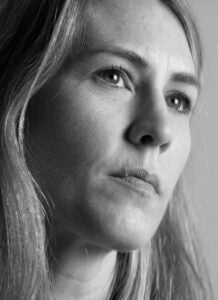
“What makes the work of Forward Through Ferguson really untraditional, in the context of nonprofits, is that typically we think about nonprofits as providing direct services,” says Adelaide Lancaster, co-founder of the nonprofit We Stories, and a Forward Through Ferguson board member. “We think of, ‘This amount of money gives this amount of people this amount of product, and we can see a machine and a service-delivery process that reminds us of charity and reminds us of nonprofit work and we call that philanthropy.’ Forward Through Ferguson doesn’t do that. It doesn’t do that by design,” she says.
“What Forward Through Ferguson does is both provide us a mirror and a North Star,” Lancaster says. “It tells us where we’ve been as a region. It reminds us what we’ve committed to and how we’ve committed to do that work and it keeps pushing us to think about where we’re going and how we want to get there.”
Lancaster adds that “Forward Through Ferguson is really unique in the context of St. Louis, because it’s unflinching — it owns our history and it names things for what they are. It does not put the burden of inequity on the most impacted people. … As an organization, it is incredibly aspirational, and being aspirational as a nonprofit is not easy. There are certain ways to get funding, there are certain ways to package yourself for people, particularly in this region, and it doesn’t let the ease of those things dictate the way it shows up in the community or the work that it does.
“I think because it has been unflinching in its analysis and because it’s so clearly centered race and racism as the core of the problem for our region … it is always asking us to consider the role of race, and to disaggregate the data, and to think about ‘For whom?’”, Lancaster says.
“It doesn’t let us escape the reality that we live in.”
Chapter 4: ‘The way that we practice doing business has completely, radically changed’ >